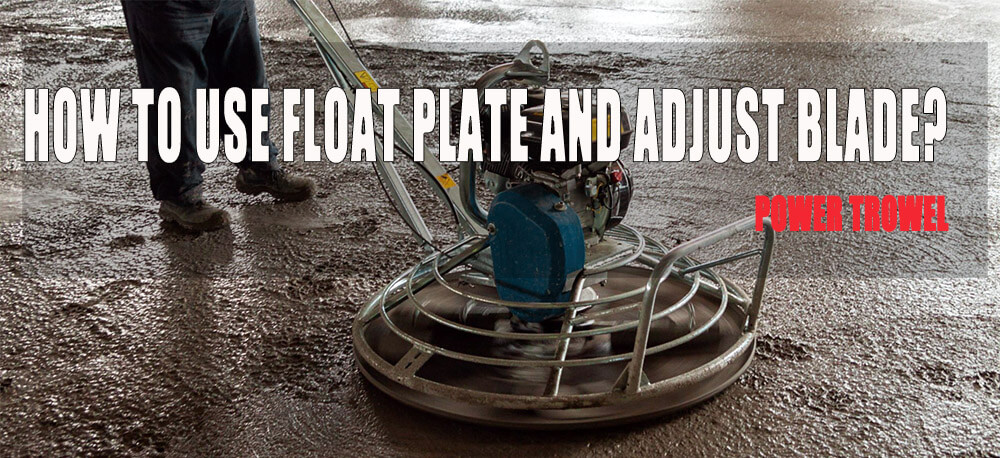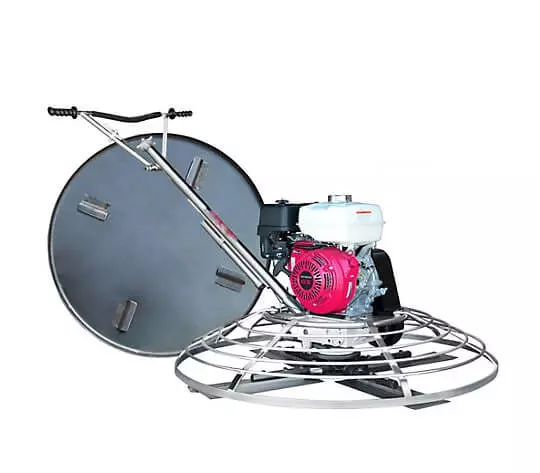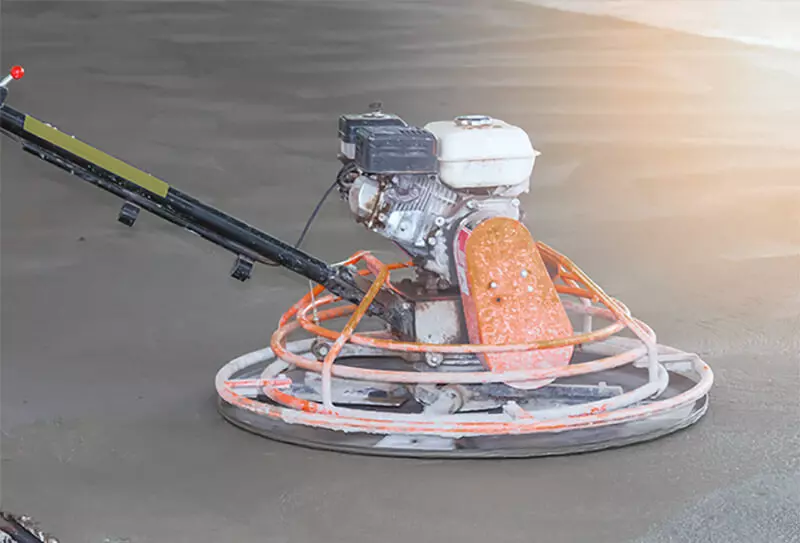20Jan 2024
table of contents

Power trowel, often referred to as "power float", is an essential tool in the process of finalizing concrete surfaces. Chiefly used to produce precise, smooth, and long lasting concrete surfaces, thereby increasing its longevity and aesthetics.
Power trowels primarily come in two main types: walk behind & ride on power trowels. While both are designed to accomplish the same task, they differ in size, control mechanisms, and usage settings. Walk behind models are ideal for small to medium-sized jobs, while ride-on models are typically used on larger, more extensive concrete surfaces.
This time BISON will first take you to understand the basic accessories of concrete power trowel, which are float pan and trowel blade. Since these accessories have a significant impact on the quality of the finish, it is necessary for us to learn how to use a float pan and adjust trowel blade.
Power trowel float pan, often referred to simply as a "float," is an integral part of a power trowel unit. Float pan resembles a giant oversized disc that attaches to the underside of power trowel and has a definite purpose during the concrete finishing process. Its role is to perfectly distribute wet concrete during the early stages of the finishing process. By doing so, it perfectly prepares the surface for further fine-tuning and smoothing, laying the foundation for a refined finish.
When discussing float pans, two key differences define their category: shape and size. In terms of shape, you'll find flat float pans and slightly curved float pans. Flat float pan trowels are great for achieving complete coverage on fresh concrete and help ensure a flat, even surface because they distribute the weight of power trowel evenly across the surface. A slightly curved float pan, on the other hand, works wonders on preset concrete, allowing you to more precisely adjust the finish to its shape.
Size is equally important when deciding which float pan to use. Float pans for power trowels vary greatly in diameter, ranging from the compact sizes utilized by smaller power trowels to the larger widths associated with ride-on models. The choice of float size should correspond to the specific requirements of the task, as well as the type of trowel blade being applied.
A piece of advice for beginners who are new to troweling: Start simple. Start with a flat float pan, then move on to curved float pans for more complex tasks.
Now that you know this, how do you use it effectively to create a beautiful, durable surface on concrete? Need to go through those following steps:
Place the float pan on the surface: Start by placing the float pan on the concrete surface. Most float pans come with clips or mounting brackets that allow you to securely attach them to your power trowel. Make sure these connections are tight, as any misalignment will result in uneven float, resulting in a poor concrete surface.
Set float pan angle: After connecting float pan, the next step is to set the float pan angle. This directly affects how vigorous or gentle the smoothing process is. Sharp angles between the float pan and the surface generally result in more aggressive compaction and smoothing, while blunter angles provide a softer feel. For beginners, it may be worth starting at a gentler angle to ease into the process.
Engage the blade with float pan: It's time to fire up the power trowel. Start the power trowel slowly, allowing the machine to gradually accelerate and engage the blade with float pan.
In addition to understanding the purpose and operation of float pan, it is equally important to understand another important component: power trowel blade.

Adjusting power trowel blade is crucial to getting the right finish. The pitch of the blade determines how much contact the blade has with the concrete, thus affecting smoothness and finish levels. Knowing how to properly adjust these blades within the project timeline can have a significant impact on the final quality and appearance.
There are two main types of power trowel blades: combination blades and finishing blades.
Combination Blades: Located in the middle of the range, wider than floating blades but smaller than finishing blades. This dual nature makes them ideal for contractors looking for a balance between initial surface smoothness and final finish. They work efficiently during the floating and finishing stages of concrete, providing full coverage and a satisfying finish.
Finishing Blades: Typically used in the final stages of finishing concrete. Their angles and construction are more precise, focusing on minimizing surface imperfections and achieving a polished, smooth surface. These blades are often the first choice for final touches on concrete surfaces that require fine adjustments, precise control and a high-quality finish.
The steps involved in adjusting an power trowel blade focus on three key areas: verifying blade alignment, adjusting blade spacing and angle, and ensuring proper blade overlap.
Check Blade Alignment: First make sure the blade is installed and properly aligned. Alignment prevents uneven wear of the blade and ensures the spatula operates efficiently. To do this, turn off power trowel and tilt it to one side or place the handle on a raised surface so that the blade is exposed. Check the blades to make sure they are straight and the edges are not twisted or damaged. Misalignment may result in uneven trimming or may cause long-term mechanical problems with the power trowel.
Adjust Pitch and Angle: After aligning the blades correctly, next we adjust their pitch and angle. As we mentioned before, blade spacing determines how hard the trowel will smooth the concrete. Most power trowels are equipped with a pitch control. Lowering the pitch will make the trowel's action gentler on the surface, while raising the pitch will increase the smoothing and finishing effect.
Additionally, adjusting the angle of the blade is critical to how well the blade contacts the concrete. The steeper the angle, the more contact the blade surface has with the concrete, which in turn means more aggressive smoothing and finishing. Depending on your requirements, adjust the angle to suit the desired surface finish.
Make Sure Blades Overlap Properly: The last part of the blade adjustment process involves making sure the blades overlap properly. In order to achieve an even finish and prevent any rounding marks on the edge of power trowel blade, it is crucial to maintain some degree of overlap. This usually involves extending the finishing blade beyond the circumference of the float pan.
Keep in mind that each power trowel model may have slightly different adjustment methods and features, so it's best to consult the device's user manual for more specific adjustment steps.

In this comprehensive guide, we cover everything from a basic introduction to power trowels, types, to an in-depth look at the proper use of this important piece of concrete power trowel equipment, including float pans and blade adjustments.
Beyond that, whether you're marking the depth of the concrete or starting the floating process, timing is very important. When using a power trowel, starting work on unhardened concrete too early can cause problems such as sinking or over-smoothing. Additionally, waiting for excess moisture to evaporate from the surface before starting the troweling operation will result in a better, more consistent finish.
Like any other piece of equipment, power trowels require proper maintenance. Consistent inspection of blades and float pans, coupled with replacement of worn materials, will ensure your power trowel runs efficiently and lasts longer. Proper storage significantly contributes to ensuring the tools' functionality and longevity.
The performance and final output quality of a power trowel is always related to the quality of the components you use, especially the float pan and blades. Premium materials like stainless steel blades tend to last longer and have a better surface finish than their cheaper counterparts. Investing in quality now, not only will save a lot of time, but also effort and money in maintenance, replacement and rework.
For a consistently reliable and high-performing power trowel, we present to you BISON power trowels. A combination of rugged design and premium components, to ensure optimal results every time you use them. We invite you to experience the BISON difference.
inquiry form here
BISON BLOG, All the latest news and views from Bison Machinery.